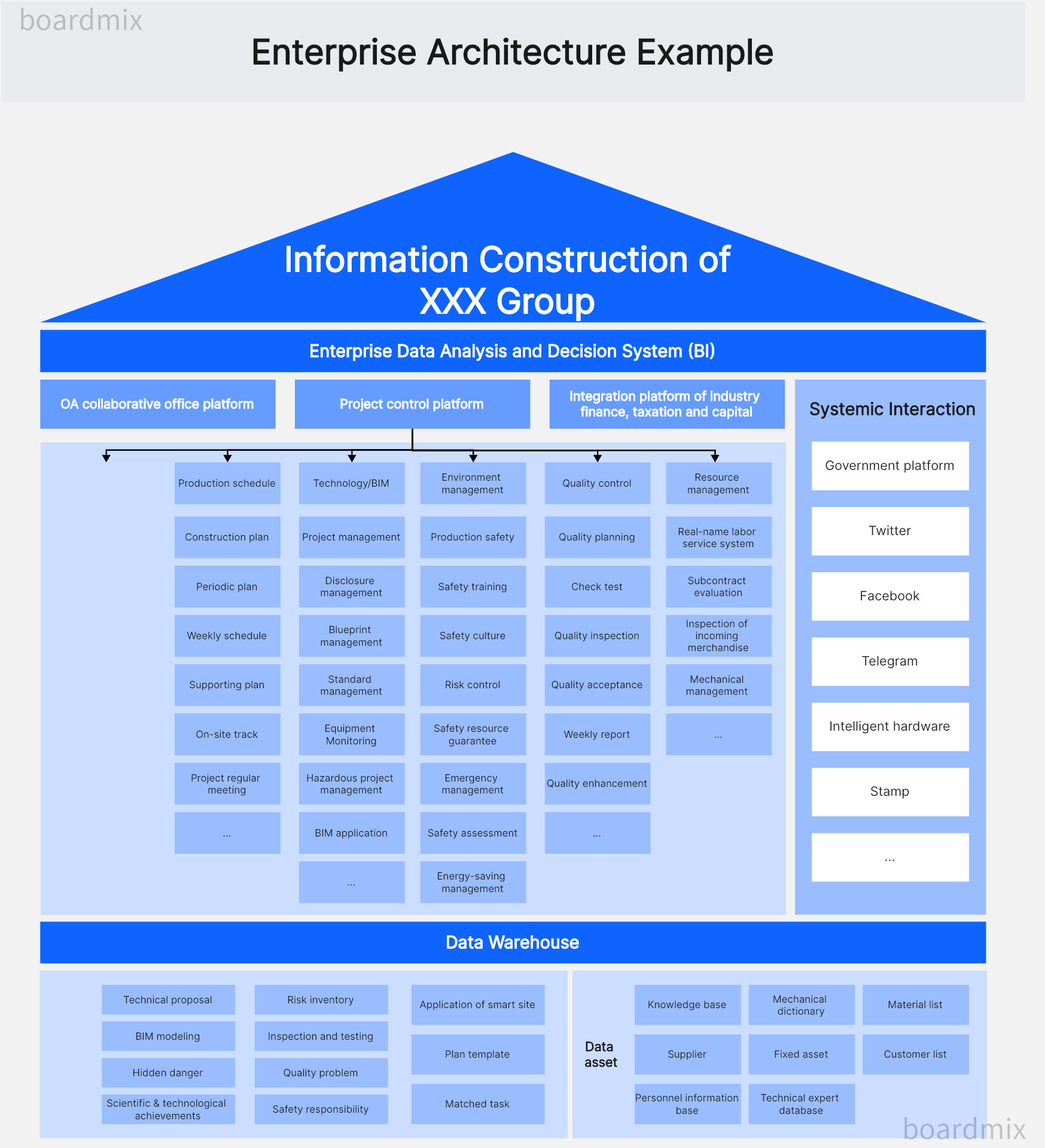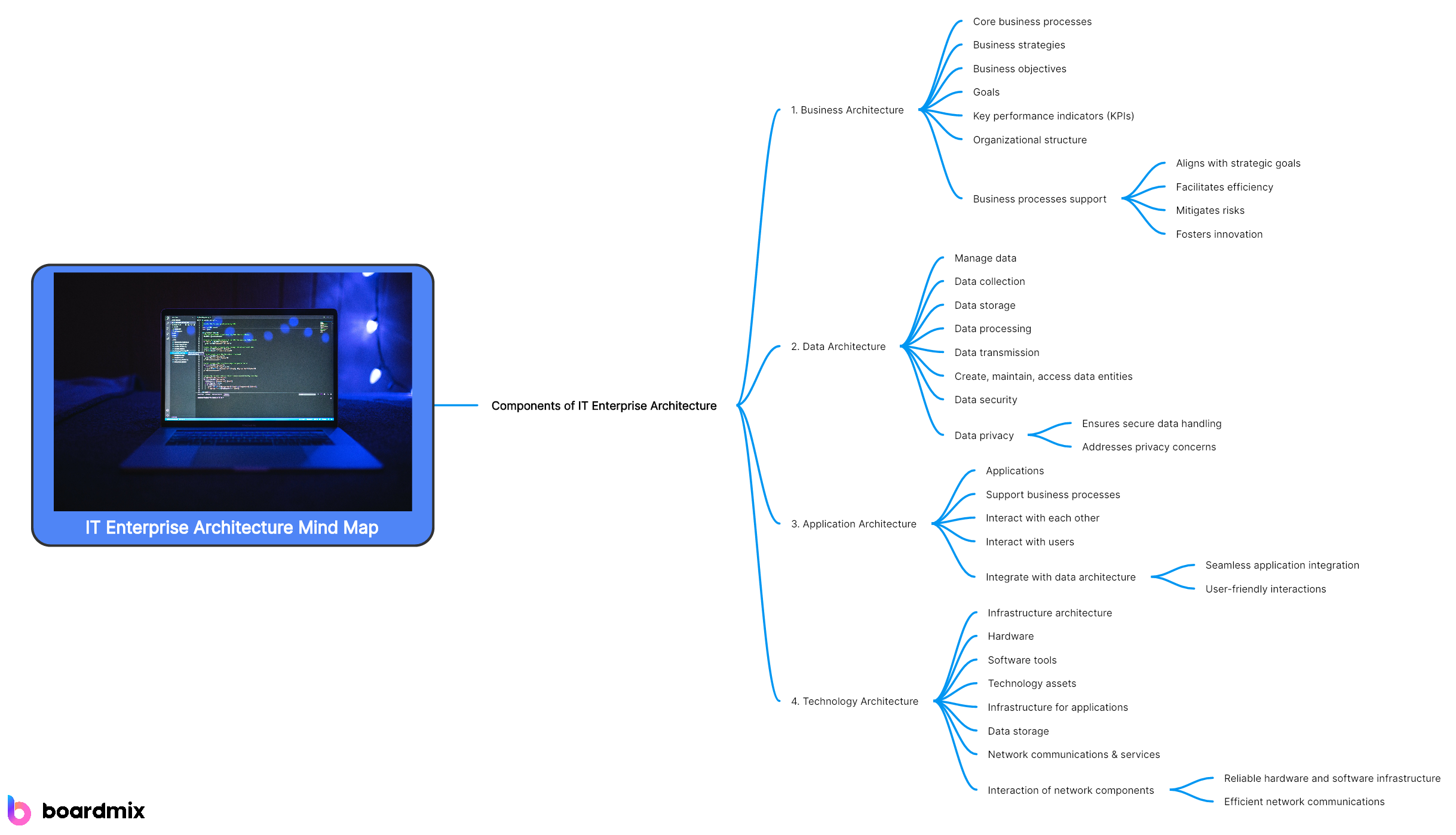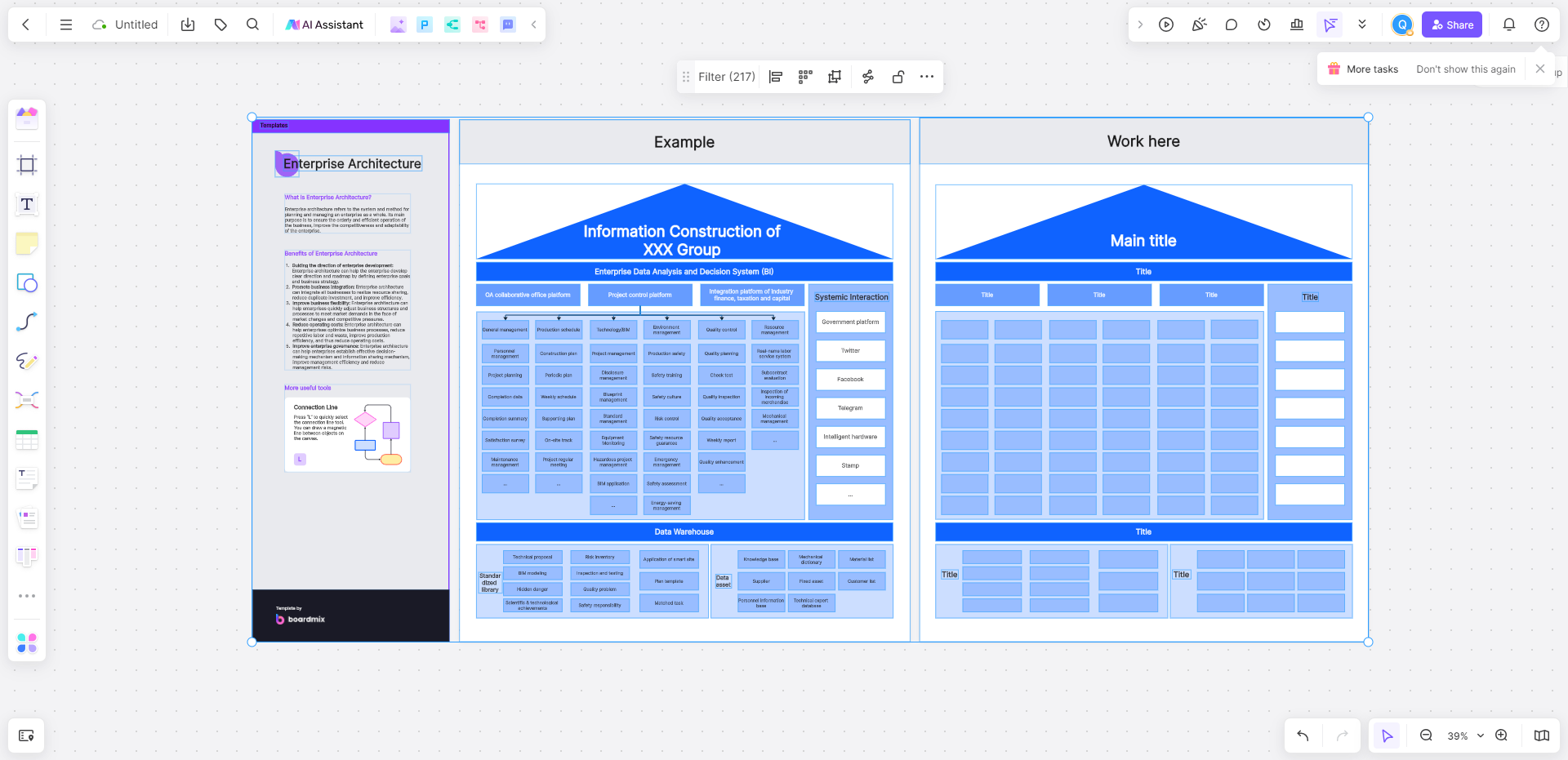What Is Enterprise Architecture in IT?
Enterprise architecture in IT refers to the practice of designing and organizing an organization's IT systems and infrastructure to align with its business goals and objectives. It involves creating a blueprint or framework that outlines how different IT components, such as hardware, software, networks, and databases, should be structured and integrated to support the organization's overall operations. The goal of enterprise architecture in IT is to ensure that the organization's IT systems are efficient, secure, and capable of meeting its current and future needs. It also helps in identifying areas of improvement and making informed decisions about technology investments.

What Are the Four Components of IT Enterprise Architecture?
IT architecture is a framework that describes how an organization's IT resources are organized and interact to support its business goals. Here are the four key components of IT enterprise architecture:

1. Business Architecture
Business architecture describes the core business processes and strategies of an organization, and how these processes support its business objectives and goals. This includes clarifying business strategies, key performance indicators (KPIs), business processes, and organizational structure.
2. Data Architecture
Data architecture covers managing all data within an organization, including how data is collected, stored, processed, and transmitted. It defines how to create, maintain, and access data entities while considering data security and privacy.
3. Application Architecture
Application architecture involves the applications that support the organization's business processes and requirements. It defines how applications interact with each other, interact with users, and integrate with data architecture.
4. Technology Architecture
Technology architecture (infrastructure architecture) involves hardware, software tools, and other technology assets that provide the infrastructure needed to run applications and store data. It also includes how network communications & services interact with each other.
These four components are closely related to each other & together constitute a complete IT enterprise architecture. When they work in harmony, the IT enterprise architecture can effectively support an organization's strategic goals, increase efficiency, reduce risks, and aid in achieving innovation.
What Are the Three Types of IT Enterprise Architecture?
In the field of IT, there are usually three main types of architecture, each focusing on different organizational needs and goals. Here is an overview of these three types of IT enterprise architecture.
1. Enterprise Architecture
Enterprise architecture is a comprehensive perspective that describes how the entire organization works together, including its business processes, IT systems, data flows, and more. It ensures that all parts are working in the same direction to support the organization's strategic goals. Enterprise architecture can provide a framework that allows decision-makers to see the global impact of their IT investments and helps them better plan and manage resources.

2. Application Architecture
Application architecture mainly focuses on the organization's application software and services. This includes how applications are designed, implemented, and interacted with, and how they communicate with users, data, and other applications. Application architecture helps guide development teams to ensure quality, performance, security, and future maintainability while meeting business needs.
3. Technology Architecture
Technology architecture, also known as infrastructure architecture, mainly focuses on hardware and software that support applications and data assets. This includes physical devices, networks, operating systems, and storage solutions, etc. Technology architecture can help determine appropriate technology choices & plan long-term development of IT infrastructure to meet changing business needs.
These three types of architectures each focus on different aspects of the IT environment but have supporting business objectives & improving efficiency as their core goals. In practice, they need to work closely together to ensure the effective implementation of an organization's overall IT strategy.

What Is the Role of EA in IT Planning?
Enterprise Architecture (EA) plays a core role in IT planning, with its main functions as follows.
1. Providing a Global Perspective
EA provides a global, unified perspective for IT planning. By identifying and understanding the interrelationships among all IT resources, EA can help decision-makers better understand and manage the entire IT environment, enabling them to plan and make decisions more effectively.
2. Bridging Business and Technology
EA serves as a bridge between business needs and technology implementation. Through an understanding of business goals and strategies, as well as in-depth research on existing technology assets and capabilities, EA can help ensure that IT planning is closely aligned with business objectives.
3. Formulating Strategic Roadmaps
EA provides an important framework for formulating long-term IT strategic roadmaps. This includes not only identifying and evaluating future technology trends and opportunities but also a detailed analysis of how existing technology assets can support these future needs.
4. Risk Management
EA also plays a key role in risk management. By systematically identifying and assessing potential risks in the IT enterprise architecture, EA can help organizations better prepare for and respond to various risks, whether they are about security, compliance or other IT-related risks.
5. Supporting Change Management
In a constantly changing business environment, EA can help organizations better cope with change. By providing an architecture that is both flexible enough to adapt to new requirements and stable enough to ensure continuity and consistency, EA enables organizations to meet current needs while also preparing for future changes.
In summary, Enterprise Architecture plays a key role in IT planning. It not only helps decision-makers better understand & manage their IT environment but also provides an effective way to achieve business goals & strategies.
Why EA Tools Are Important in IT Enterprise Architecture
The importance of Enterprise Architecture (EA) tools in IT enterprise architecture cannot be overlooked. Here are some reasons:
1. Unified View
Enterprise architecture tools provide a global and unified view for the organization, which is necessary in various IT systems and complex environments. It helps decision-makers understand and visualize how the entire IT enterprise architecture works, enabling them to better plan and manage IT resources.
2. Supports Decision-Making
Enterprise architecture tools can provide data-driven insights for IT strategy and decision-making. By presenting the current technological state of the organization, they can reveal potential improvement points and support wiser investment decisions.
3. Enhances Collaboration
These tools often help enhance collaboration between departments and teams as they provide a shared framework for understanding the organization's IT environment. This can help promote consistency, avoid redundancy, and ensure everyone is aligned with enterprise goals.
4. Promotes Standardization
By using enterprise architecture tools, organizations can drive and implement technology standardization, which helps reduce complexity, improve efficiency, and lower costs.
5. Improves Planning & Roadmap Creation
These tools assist in creating & maintaining IT strategic roadmaps. They're capable of tracking & visualizing future IT landscape aiding better planning & management of changes.
6. Risk Management
By using enterprise architecture tools, organizations can better identify & manage risks associated with IT enterprise architecture such as security threats or compliance issues.
The importance of enterprise architecture tools in IT enterprise architecture mainly lies in their ability to help organizations more effectively understand/manage/improve their IT environment. Whether it's supporting strategic decisions or optimizing daily operations, they play an indispensable role.
How to Apply EA in the IT Industry
Enterprise Architecture (EA) is the process of aligning an enterprise's business objectives with its IT strategy. Here are the specific steps on how to apply enterprise architecture in the IT industry.
1. Clarify Business Objectives and Strategies
First, it is necessary to understand and clarify the organization's business objectives and strategies. This includes understanding the organization's vision, as well as the specific goals that need to be achieved to realize this vision. This provides a foundation and direction for enterprise architecture.
2. Understand Current Architecture
Before designing a new architecture, it is necessary to understand the existing architecture and its problems. This includes understanding existing business processes, IT systems, and data flows, as well as their relationships. Understanding the strengths and weaknesses of the existing architecture can provide important guidance for the new architecture.
3. Define New Architecture
Based on an understanding of business objectives and current architecture, a new enterprise architecture can be defined. This includes determining new business processes, IT systems, and data flows, and defining their relationships. In this process, some enterprise architecture models or frameworks may be used, such as TOGAF or Zachman framework.
4. Develop Implementation Plan
After determining the new architecture, a detailed implementation plan needs to be developed. This includes determining resources required for implementing new architectures, time schedules, responsible persons, etc. In this process, some implementation risks may need consideration & corresponding risk response strategies should be formulated.








